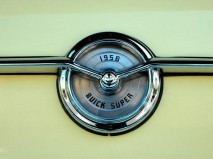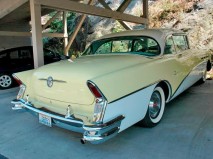1957 Buick Super Riviera
en.wikipedia.org
The Buick Super is a full-sized automobile produced from the 1940 through the 1958 model years (excluding WW II); it was built on Buick's larger body shared with the Roadmaster. It and the Roadmaster were replaced by the Electra in 1959.
Body style: 4-door Riviera hardtop , 2-door Riviera hardtop, 2-door convertible
Platform : C-body
Engine : 364 cu in (6.0 L) Nailhead V8
Transmission: 2-speed Dynaflow automatic
Wheelbase : 127.5 in (3,239 mm)
Length 1957: 215.3 in (5,469 mm)
Width: 79.8 in (2,027 mm)
Height : 60.0 in (1,524 mm)
Curb weight : 4,500–4,700 lb (2,000–2,100 kg)
Related : Cadillac Series 62 , Buick Limited , Buick Roadmaster ,Oldsmobile 98
Designer(s) Harley Earl
The Super used the new General Motors C-body for 1957. Larger than the Series 40 Special and Series 60 Century B-body, the Riviera body styles had different roof treatments as well. Supers had a group of three Chevrons on each rear quarter or door for series identification, in addition to the normal wording within the grille and deck emblems. Four VentiPorts were used on each front fender. Closed models were upholstered in Nylon/Cordaveen combinations while the convertible had an all-Cordaveen interior and featured power windows and seat controls as part of its equipment. Standard Super equipment included foam rubber seat cushions, automatic trunk lamp, Red Liner speedometer, glovebox lamp, dual horns, trip mileage indicator, directional signals, dual sunshades, color coordinated dash panel, and on the convertible, outside left-hand rearview mirror. The 4-door pillared sedan body style was gone. Engine displacement was increased to 364 cu in (6.0 L) on the Nailhead V8. Nevertheless, sales fell to 70,250, the lowest level with the exception of the abbreviated 1942 model year.
The once most popular Buick line was reduced to two body styles for 1958 with the elimination of the convertible. Side trim was similar to lesser series, except for the Super lettering on the rear fender flashes, but Supers were longer than the Series 40 Specials and Series 60 Centurys. The Super name was also lettered across the deck lid. Standard equipment included Variable-Pitch Dynaflow, power steering, power brakes, a safety-cushion instrument panel, fully carpeted floor, courtesy lights, full wheelcovers, foam rubber cushions, electric clocks, dual horns, ignition key light, glovebox, cigar lighter, trip mileage indicator, geared vent panes, bumper guards, variable speed wipers, Step-On parking brakes, and, on convertibles, an outside rearview mirror. Interiors were trimmed with gray cloth and vinyl or Cordaveen and vinyl. A plusher Custom interior was available at extra cost. Sales fell further to 42,388, the lowest with the exception of the wartime 1942 model year.
The Super name has been resurrected on the new special-edition LaCrosse and Lucerne models.









